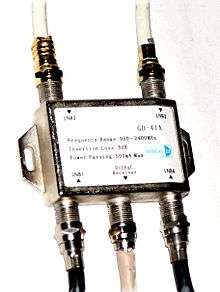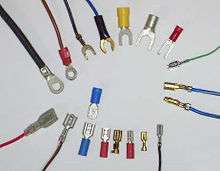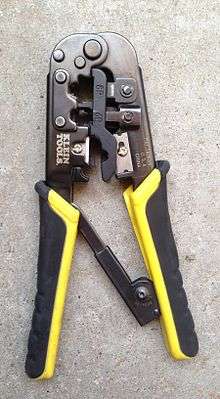Crimp (joining)
Crimping is joining 2 pieces of metal or other ductile material (usually a wire and a metal plate) by deforming one or both of them to hold the other. The bend or deformity is called the crimp.


Process
Typically, the metals are joined together via a special connector. Stripped wire (often stranded) is inserted through the correctly sized opening of the connector, and a crimper is used to tightly squeeze the opening against the wire. Depending on the type of connector used, it may be attached to a metal plate by a separate screw or bolt or it could be simply screwed on using the connector itself to make the attachment like an F connector.
Obtaining a good crimp requires using carefully engineered crimp tools and crimp connectors, and following the procedures specified by the manufactures. Examples of these procedures can be obtained from Molex,[1] TE Connectivity,[2] and other similar companies.
Uses
Crimping is most extensively used in metalworking. Crimping is commonly used to fix bullets in their cartridge cases, for rapid but lasting electrical connections, securing lids on metal food cans, and many other applications. Because it can be a cold-working technique, crimping can also be used to form a strong bond between the workpiece and a non-metallic component.
Types
Overarching styles:
- Insulated vs. Non-Insulated terminals
- wire crimp vs. insulation crimp
- B crimp
- C crimp[5]
- D crimp[6]
- F crimp originally designed and named by AMP Incorporated, used only on non-insulated connectors, such as Packard 56, Weather Pack, and Metri Pack
- O crimp
- W crimp
- Confined (oval) crimp
- Crescent crimp
- Four-Mandrel crimp
- Hex crimp
- Mandrel (indent) crimp
- OVL crimp
- Square crimp
- Trapezoid crimp
- Trapezoidal crimp
- Tyco crimp
- Western crimp
Crimped Terminals

- Blade
- Bullet
- FASTON terminal quick-disconnect
- Wire pin
- Ring tongue
- Rectangular tongue
- Spade tongue
- Flanged spade tongue
- Short spring spade tongue
- Long spring spade tongue
- Slotted ring tongue
- Hook tongue
- Multiple stud
- Offset ring tongue
- Flag tongue
- Butt splices
- SHUR-PLUG
- Pin (SAE/J928)[7]
Wire Gauge Insulation Colors
As defined in AMP Standard Terminals and Splices[8]
| Insulation Color Code | Wire Size Range AWG | Comments |
|---|---|---|
| Yellow | 26–22 | |
| Transparent | 24–20 | |
| Red | 22–16 | |
| Blue | 16–14 | |
| Yellow/Black | 16–14 | Heavy Duty |
| Yellow | 12–10 | |
| Red | 8 | |
| Blue | 6 | |
| Yellow | 4 | |
| Red | 2 | |
| Blue | 1/0 | |
| Yellow | 2/0 | |
| Red | 3/0 | |
| Blue | 4/0 |
Development History
According to one of the crimp tool manufacturers, the development of standardized crimp tools and procedures occurred on this timeline.[9]
- 1940's All terminations were soldered (Hard-wired)
- 1953 AMP introduced Crimp Barrel Terminals
- 1957 Cannon Brothers experimented with Machined Contacts with Crimp Barrels
- 1960 Buchanan introduced the MS3191-1 4 Indent Crimp Tool with a Ratchet[10]
- 1963 MS3191-1 was published as the first Crimp Tool Standard
- 1965 MS3191-4 introduced by Daniels Manufacturing Corporation
- 1969 MIL-T-22520 published and dated to replace all previous specifications
- 1974 Changed to MIL-C-22520, and many Slash Sheets added
- 1996 Changed to MIL-DTL-22520
- 2010 Changed to AS22520[11]
See also
External links
| Look up crimp in Wiktionary, the free dictionary. |
References
| Wikimedia Commons has media related to Crimping. |
- ↑ "INDUSTRIAL CRIMP QUALITY HANDBOOK" (PDF). Retrieved 11 July 2015.
- ↑ "Good Crimping Guide". Retrieved 11 July 2015.
- ↑ "Crimp symbols".
- ↑ "Forms of Crimping".
- ↑ "Electronic Installation Practices Manual". NAVSHIPS 900171 (U.S. Navy). 23 May 1952. Retrieved 12 July 2015.
- ↑ "2.8 mm Apex Terminal Crimp Guidelines" (PDF). Retrieved 12 July 2015.
- ↑ "Electrical Terminals--Pin and Receptacle Type". Retrieved 11 July 2015.
- ↑ "AMP Standard Terminals and Splices" (PDF).
- ↑ "Crimping Facts". Retrieved 11 July 2015.
- ↑ "Standard Self-Adjusting Crimp Tool MS3191". Retrieved 11 July 2015.
- ↑ "MIL-DTL-22520: Crimping Tools, Wire Termination, General Specification for". Retrieved 11 July 2015.
